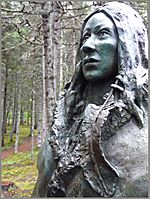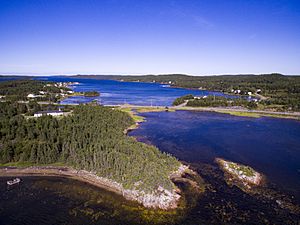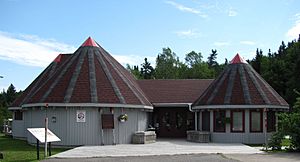Boyd's Cove, Newfoundland and Labrador facts for kids

Boyd's Cove, also called Boyd's Harbour, is a small town in Newfoundland and Labrador, Canada. It's close to Lewisporte. People here have traditionally worked in fishing, cutting timber, and farming. This area is special because it has an interpretive center. This center teaches visitors about the Beothuk people who lived here long ago.
Contents
Exploring Boyd's Cove: Where Is It?
Boyd's Cove is located in a natural area called the North Shore Forest. The coastline here is very calm and protected. This is because large islands nearby block strong winds and waves. Route 340 goes right through Boyd's Cove. This road then crosses a special bridge called a causeway. It leads the way to Twillingate, another interesting place.
Who Lives in Boyd's Cove Today?
In 2016, about 183 people lived in Boyd's Cove. The town has important services for its residents. These include an ambulance service and a recreation center for fun activities. There's also a fire hall to keep everyone safe. Most people living in Boyd's Cove now are older adults. This is because many younger families have moved away to find jobs. Even with fewer young people, the town is still a close-knit community.
The Beothuk interpretive center is a big part of the community. It hosts many educational events. You can find book launches and special ceremonies there. The center also features a beautiful bronze statue. It's called "The Spirit of the Beothuk" and was created by Gerald Squires.
A Look Back: The History of Boyd's Cove
Boyd's Cove has a rich history, starting with the Beothuk people. They were the first to settle here in the late 1700s. During the warm summer months, the Beothuk lived by the cove. They built their homes, called wigwams, over shallow holes in the ground.
The Beothuk were very clever. They used traditional tools and also found metal items. These metal pieces were left behind by French and English fishing camps. The Beothuk would reshape these metals to make their own useful tools. Sadly, the Beothuk people faced many challenges. Their population decreased due to illnesses and a lack of food. This was partly because European settlers moved into their lands.
Later, in the late 1800s, new families settled in Boyd's Cove. These families, like the Freakes, Newmans, and Robinsons, came from Fogo Island. Other settlers also arrived from the Change Islands. At first, Boyd's Cove was a place for logging and fishing. Over time, it became known for growing vegetables. Farmers here grew turnips, carrots, potatoes, and hay. Because of its safe, sheltered location, Boyd's Cove often welcomed people from other, more exposed fishing villages during the winter.
Life in Boyd's Cove was often tough. The landscape was rugged, and the weather could be harsh. Getting medical help was very difficult. In the 1920s and 1930s, the nearest hospital was far away. It took almost 1½ hours to reach Lewisporte by horse. For serious illnesses, people had to travel all the way to St. John's.
Uncovering the Past: Archaeology at Boyd's Cove
Boyd's Cove is home to a very important Beothuk archaeological site. Dr. Ralph T. Pastore from Memorial University of Newfoundland led excavations here in the early 1980s. Today, this site is where the Boyd's Cove Interpretation Centre stands.
Archaeologists have found evidence that people have lived in Boyd's Cove for about 2000 years! They discovered Beothuk pit houses from the late 1600s or early 1700s. Near these houses, they found stone tools right next to European items. This discovery helped scientists understand the connection between the Beothuk and their ancient ancestors.
Studying animal bones found at the site showed that the Beothuk lived there for much of the year. They stayed from late winter until fall. This means they used both sea animals and land animals for their food. Because of its historical importance, the Boyd's Cove site was named a National Historic Site of Canada in 1995.
Images for kids










